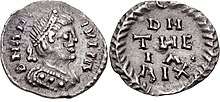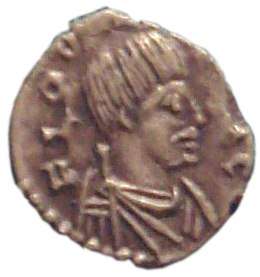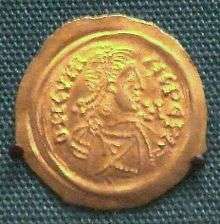Teia
Teia (died 552 or 553 AD), also known as Teja, Theia, Thila, Thela, and Teias, was the last Ostrogothic King of Italy. He led troops during the Battle of Busta Gallorum and had noncombatant Romans slaughtered in its aftermath. In late 552/early 553, he was killed during the Battle of Mons Lactarius. Archaeological records attesting to his rule show up in coinage found in former Transalpine Gaul.

Life
Teia (Teja) was a military officer serving under Totila, who was chosen as his successor and raised over a shield after Totila was killed in the Battle of Taginae (also known as the Battle of Busta Gallorum) in July 552.[1] After this major Gothic defeat and in an act of revenge, Teia ordered the death of all the Roman senators in Campania including Flavius Maximus, who had been exiled by Belisarius. He also had some 300 Roman children slaughtered, whom Totila had held hostage.[2] Teia then made his way to Pavia, where he took possession of the available treasures and as the new king, made a pact with the Franks.[3]
On his way fleeing to southern Italy, he gathered support from prominent figures within Totila's armies, including Scipuar, Gundulf (Indulf), Gibal and Ragnaris, to make his last stand against the Byzantine eunuch general Narses at the Battle of Mons Lactarius, south of present-day Naples, near Nuceria Alfaterna, in late 552/early 553.[3] Historian Guy Halsall called this battle, which occurred in the shadow of Mount Vesuvius, a "cataclysmic showdown."[4] The Ostrogothic army was defeated there and Teia fell during the fighting.[5] Scipuar and Gibal were probably also killed. Those Goths who survived the battle and remained negotiated an armistice.[6] Gundulf and Ragnaris escaped from the field; the latter was later mortally wounded after a failed assassination attempt by an agent of Narses.[7] With that defeat, organized Ostrogothic resistance ended. By 554, the Ostrogothic Kingdom had faded into obscurity, and the Gothic people who remained began assimilating into the broader Italian population.[8]
Although his reign was brief, silver coins in his name circulated all the way from his capital Pavia along the Alpine trade routes into Gaul.[9]
References
- Norwich 2001, pp. 91–92.
- Geary 2002, p. 113.
- Wolfram 1997, p. 238.
- Halsall 2007, p. 505.
- Wolfram 1988, p. 247.
- Heather 2013, p. 165.
- Norwich 2001, p. 92.
- Burns 1991, p. 215.
- Burns 1991, p. 214.
Bibliography
- Burns, Thomas (1991). A History of the Ostrogoths. Bloomington; Indianapolis: Indiana University Press. ISBN 978-0-25320-600-8.CS1 maint: ref=harv (link)
- Geary, Patrick J. (2002). The Myth of Nations: The Medieval Origins of Europe. Princeton, NJ: Princeton University Press. ISBN 978-0-69109-054-2.CS1 maint: ref=harv (link)
- Halsall, Guy (2007). Barbarian Migrations and the Roman West, 376–568. Cambridge and New York: Cambridge University Press. ISBN 978-0-52143-543-7.CS1 maint: ref=harv (link)
- Heather, Peter (2013). The Restoration of Rome: Barbarian Popes and Imperial Pretenders. Oxford and New York: Oxford University Press. ISBN 978-0-19936-851-8.CS1 maint: ref=harv (link)
- Norwich, John J. (2001). Bisanzio: Splendore e decadenza di un Impero, 330–1453 (in Italian). Milano: Mondadori. ISBN 978-8-80449-922-0.CS1 maint: ref=harv (link)
- Wolfram, Herwig (1988). History of the Goths. Berkeley and Los Angeles: University of California Press. ISBN 0-520-05259-5.CS1 maint: ref=harv (link)
- Wolfram, Herwig (1997). The Roman Empire and its Germanic Peoples. Berkeley and Los Angeles: University of California Press. ISBN 0-520-08511-6.CS1 maint: ref=harv (link)
| Regnal titles | ||
|---|---|---|
| Preceded by Totila |
King of the Ostrogoths c. 552–553 |
Justinian I's victory |


